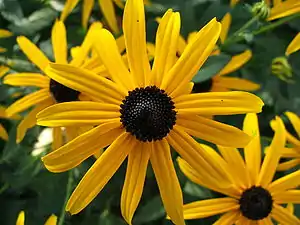| Orange Coneflower | |
|---|---|
 | |
| Binomial: | Rudbeckia fulgida |
| Type: | Herbaceuous perennial |
| Light requirements: | Full sun |
| Water requirements: | Drought tolerant (but may wilt in heat) |
| Pest issues: | Minor, but deer browsing can be a problem |
| Disease issues: | Leaf spot is common |
| Bloom season: | Early summer through autumn |
| Weediness: | Can be very weedy |
| Pollination: | Insect |
Rudbeckia fulgida, commonly known as Black-eyed Susan or Orange coneflower, is a perennial plant native to eastern North America.
In the garden, this plant spreads aggressively by both rhizomes and seed.
The ripe seed is a favorite food of finches in winter.
Description
Stems are hairy, ridged, and dark green. Leaves are dark green, sparsely but rouchly haired, simple, with sparsely serrate margins.
Flowers are heads, with black disk florets and bright orange ray florets, borne singly on stems that extend above the foliage.
Growing Conditions
Varieties
Uses
Maintenance
Controlling the spread is the most common issue. Dividing out from the edges can control the vegetative spread. Deadheading can control the seeding, but if growing to attract winter birds, the seeds need to be left on the plant.
Propagation
Easily propagated by division.
Harvest
Pests and Diseases
References